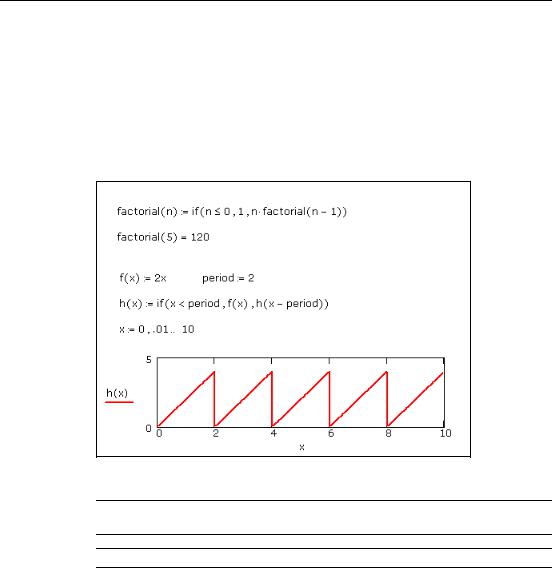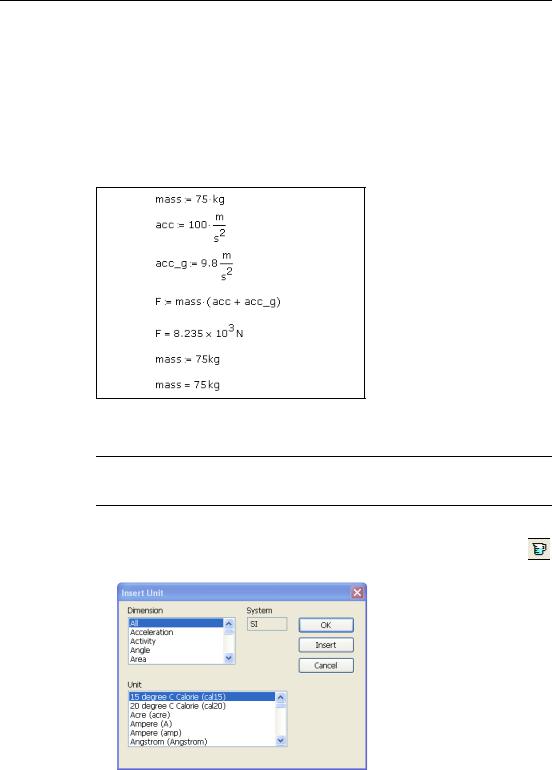
- •User’s Guide
- •Contents
- •About This Guide
- •Other Documentation
- •Other Resources
- •Technical Support
- •Comments
- •Chapter 1
- •Welcome to Mathcad
- •What Is Mathcad?
- •Highlights of the Mathcad 14 Release
- •Internationalization of Mathcad
- •Usability Features
- •New and Improved Functions
- •Math Enhancements
- •New Symbolics
- •PTC integration
- •System Requirements
- •Installation
- •Chapter 2
- •Getting Started with Mathcad
- •The Mathcad Workspace
- •Working with Worksheets
- •Regions
- •A Simple Calculation
- •Definitions and Variables
- •Defining Variables
- •Calculating Results
- •Defining a Function
- •Formatting a Result
- •Graphs
- •Creating a Basic Graph
- •Formatting a Graph
- •Saving, Printing, and Exiting
- •Saving a Worksheet
- •Printing
- •Exiting Mathcad
- •Chapter 3
- •Online Resources
- •Mathcad Resources
- •Resources Window and E-books
- •Finding Information in an E-book
- •Annotating an E-book
- •Web Browsing
- •Help
- •User Forums
- •Logging in
- •Communicating with Other Mathcad Users
- •Other Resources
- •Web Resources
- •Release Notes
- •Technical Support
- •Mathcad Downloads on the PTC Web Site
- •Chapter 4
- •Working with Math
- •Inserting Math
- •Numbers and Complex Numbers
- •Greek Letters
- •Inserting an Operator
- •Building Expressions
- •Typing in Names and Numbers
- •Controlling the Editing Lines
- •Typing in Operators
- •Multiplication
- •An Annotated Example
- •Editing Expressions
- •Changing a Name or Number
- •Inserting an Operator
- •Applying an Operator to an Expression
- •Deleting an Operator
- •Replacing an Operator
- •Inserting a Minus Sign
- •Inserting Parentheses
- •Deleting Parentheses
- •Moving Parts of an Expression
- •Deleting Parts of an Expression
- •Math Styles
- •Editing Math Styles
- •Applying Math Styles
- •Saving Math Styles
- •Chapter 5
- •Range Variables and Arrays
- •Creating Arrays
- •Vectors and Matrices
- •Insert Matrix Command
- •Iterative Calculations
- •Creating a Range Variable
- •Entering a Matrix as a Data Table
- •Accessing Array Elements
- •Subscripts
- •Accessing Rows and Columns
- •Changing the Array Origin
- •Displaying Arrays
- •Changing the Format of Displayed Elements
- •Copying and Pasting Arrays
- •Working with Arrays
- •Performing Calculations in Parallel
- •Graphical Display of Arrays
- •Chapter 6
- •Working with Text
- •Inserting Text
- •Creating a Text Region
- •Selecting Text
- •Greek Letters in Text
- •Changing the Width of a Text Region
- •Text and Paragraph Properties
- •Changing Text Properties
- •Changing Paragraph Properties
- •Text Styles
- •Applying a Text Style to a Paragraph in a Text Region
- •Modifying an Existing Text Style
- •Creating and Deleting Text Styles
- •Equations in Text
- •Inserting an Equation into Text
- •Text Tools
- •Find and Replace
- •Spell-Checking
- •Chapter 7
- •Mathcad Worksheets
- •Worksheets and Templates
- •Creating a New Worksheet
- •Opening a Worksheet
- •Saving Your Worksheet
- •Creating a New Mathcad Template
- •Modifying a Template
- •Rearranging Your Worksheet
- •Selecting Regions
- •Region Properties
- •Moving and Copying Regions
- •Deleting Regions
- •Aligning Regions
- •Inserting or Deleting Blank Space
- •Separating Regions
- •Highlighting Regions
- •Changing the Worksheet Background Color
- •Layout
- •Setting Margins, Paper Size, Source, and Orientation
- •Page Breaks
- •Headers and Footers
- •Safeguarding an Area of the Worksheet
- •Inserting an Area
- •Locking and Collapsing an Area
- •Unlocking and Expanding an Area
- •Deleting an Area
- •Worksheet Protection
- •Worksheet References
- •Hyperlinks
- •Creating Hyperlinks to a Mathcad File
- •Creating Hyperlinks to Other Files
- •Distributing Your Worksheets
- •Printing
- •Printing Wide Worksheets
- •Print Preview
- •Creating PDF Files
- •Creating E-books
- •Creating Web Pages and Sites
- •Saving Your Worksheet to Microsoft Word
- •Mailing
- •Chapter 8
- •Calculating in Mathcad
- •Defining and Evaluating Variables
- •Defining a Variable
- •Names
- •Built-in Variables
- •Evaluating Expressions Numerically
- •How Mathcad Scans a Worksheet
- •Global Definitions
- •Range Variables
- •Built-in Functions
- •Assistance for Using Built-in Functions
- •Applying a Function to an Expression
- •Defining and Evaluating Functions
- •Variables in User-Defined Functions
- •Recursive Function Definitions
- •Units and Dimensions
- •Dimensional Checking
- •Defining Your Own Units
- •Working with Results
- •Formatting Results
- •Displaying Units of Results
- •Copying and Pasting Numerical Results
- •Controlling Calculation
- •Calculating in Manual Mode
- •Interrupting Calculations
- •Disabling Equations
- •Error Messages
- •Finding the Source of an Error
- •Fixing Errors
- •Chapter 9
- •Solving
- •Solving and Optimization Functions
- •Finding Roots
- •Linear/Nonlinear System Solving and Optimization
- •Chapter 10
- •Overview
- •Inserting Pictures
- •Creating Pictures from Matrices
- •Formatting a Image
- •Inserting Objects
- •Inserting an Object into a Worksheet
- •Editing an Embedded Object
- •Editing a Link
- •Inserting Objects Computationally Linked to Your Worksheet
- •Chapter 11
- •2D Plots
- •Overview of 2D Plotting
- •Creating an X-Y Plot
- •Creating a Polar Plot
- •Graphing Functions and Expressions
- •2D QuickPlots
- •Defining an Independent Variable
- •Plotting Multiple 2D Curves
- •Creating a Parametric Plot
- •Plotting Vectors of Data
- •Plotting a Single Vector of Data
- •Plotting One Data Vector Against Another
- •Formatting a 2D Plot
- •Setting Axis Limits
- •Adding Custom Titles, Labels, and Other Annotations
- •Modifying a 2D Plot’s Perspective
- •Zooming in on a Plot
- •Getting a Readout of Plot Coordinates
- •Animations
- •Creating an Animation Clip
- •Playing an Animation Clip
- •Playing a Previously Saved Animation
- •Chapter 12
- •3D Plots
- •Overview of 3D Plotting
- •Inserting a 3D Plot
- •3D Plot Wizard
- •Creating 3D Plots of Functions
- •Creating a Surface, Bar, Contour, or Scatter Plot
- •Creating a Space Curve
- •Creating 3D Plots of Data
- •Creating a Surface, Bar, or Scatter Plot
- •Creating a Parametric Surface Plot
- •Creating a Three-dimensional Parametric Curve
- •Creating a Contour Plot
- •Graphing Multiple 3D Plots
- •Formatting a 3D Plot
- •The 3D Plot Format Dialog Box
- •Changing One 3D Plot to Another
- •Annotations
- •Modifying 3D QuickPlot Data
- •Chapter 13
- •Symbolic Calculation
- •Overview of Symbolic Math
- •Live Symbolic Evaluation
- •Using Keywords
- •Using More Than One Keyword
- •Keyword Modifiers
- •Ignoring Previous Definitions
- •Using the Symbolics Menu
- •Displaying Symbolic Results
- •Examples of Symbolic Calculation
- •Derivatives
- •Integrals
- •Limits
- •Solving an Equation for a Variable
- •Solving a System of Equations Symbolically: “Solve” Keyword
- •Solving a System of Equations Symbolically: Solve Block
- •Symbolic Matrix Manipulation
- •Index

90 / Chapter 8 Calculating in Mathcad
Recursive Function Definitions
Mathcad supports recursive function definitions — you may define the value of a function in terms of a previous value of the function. As shown in Figure 8-7, recursive functions are useful for defining arbitrary periodic functions, as well as implementing numerical functions like the factorial function.
Note that a recursive function definition should always have at least two parts:
•An initial condition that prevents the recursion from going forever.
•A definition of the function in terms of some previous value(s) of the function.
A simple recursive function definition.
Using recursion to define a periodic sawtooth wave.
Figure 8-7: Mathcad allows recursive function definitions.
Note If you do not specify an initial condition that stops the recursion, Mathcad generates a “stack overflow” error message when you try to evaluate the function.
Online Help The programming operators in Mathcad also support recursion. See Recursion in Help.
Units and Dimensions
One of Mathcad’s strengths is units and unit conversion. Units are used just like builtin variables. To assign units to a number or expression, just multiply it by the name of the unit.
Mathcad recognizes most units by their common abbreviations. By default Mathcad uses the SI unit system (the International System of Units) in the results of any calculation, but you may use any supported units you wish in creating your expressions. You can change the default system of units to MKS, CGS, U.S. or None under the Unit

Units and Dimensions / 91
Systems tab of Worksheet Options in the Tools menu. See “Displaying Units of Results” on page 95 for how to set a unit system for results.
For example, type expressions like the following:
mass:75*kg
acc:100*m/s^2 acc_g:9.8*m/s^2 F:mass*(acc + acc_g)
Figure 8-8 shows how these equations appear in a worksheet.
Figure 8-8: Equations using units. Mathcad treats the multiplication as implied when you type an expression like mass:75kg.
Tip If you define a variable that consists of a number followed immediately by a unit name, you can omit the multiplication symbol; Mathcad inserts a very small space and treats the multiplication as implied. See the definition of mass at the bottom of Figure 8-8.
To insert a unit:
1. Click in the empty placeholder and choose Unit from the Insert menu or click 
 on the Standard toolbar. Mathcad opens the Insert Unit dialog box.
on the Standard toolbar. Mathcad opens the Insert Unit dialog box.

92/ Chapter 8 Calculating in Mathcad
2.The bottom list shows built-in units, along with their Mathcad names, corresponding to the physical quantity selected in the top list. To see all available built-in units select “Dimensionless” in the top list.
3.Double-click the unit you want to insert or click the unit you want and then click “Insert.” Mathcad inserts the unit into the empty placeholder.
Note Mathcad performs some dimensional analysis by trying to match the dimensions of your selected result with one of the common physical quantities in the top list. If it finds a match, all the builtin units corresponding to the highlighted physical quantity appear in the bottom list. If nothing matches, Mathcad simply lists all available built-in units on the bottom.
Dimensional Checking
Whenever you enter an expression involving units, Mathcad checks it for dimensional consistency. If you add or subtract values with incompatible units or violate other principles of dimensional analysis, Mathcad displays an appropriate error message.
For example, suppose you had defined acc as 100 m ⁄ s instead
of 100 m ⁄ s2 as shown at right. Since acc is in units of velocity and g is in units of acceleration, it is inappropriate to add them together. When you attempt to do so, Mathcad displays an error message that specifies how the dimensions mismatch.
Other unit errors are usually caused by one of the following:
•An incorrect unit conversion.
•A variable with the wrong units.
• Units in exponents or subscripts (for example v3 acre or 23 ft ).
•Units as arguments to inappropriate functions (for example, sin(2 s)).
Defining Your Own Units
You may want to define your own units or use your own abbreviation for a unit.
Define your own units in terms of existing units in exactly the same way you define a variable in terms of an existing variable. Figure 8-9 shows how to define new units as well as how to redefine existing units.
Note Since units behave just like variables, you may run into unexpected conflicts. For example, if you define the variable m in your worksheet, you cannot use the built-in unit m for meters anywhere below that definition. However, Mathcad automatically displays the unit m in any results involving meters. Mathcad will warn you if you redefine a built-in unit by underlining the redefinition with a wavy, green line.
